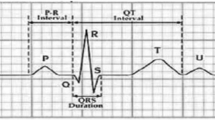Abstract
Myocardial infarction (MI), is commonly known as a heart attack, occurs when the blood supply to the portion of the heart is blocked causing some heart cells to die. This information is depicted in the elevated ST wave, increased Q wave amplitude and inverted T wave of the electrocardiogram (ECG) signal. ECG signals are prone to noise during acquisition due to electrode movement, muscle tremor, power line interference and baseline wander. Hence, it becomes difficult to decipher the information about the cardiac state from the morphological changes in the ECG signal. These signals can be analyzed using different signal processing techniques. In this work, we have used multiresolution properties of wavelet transformation because it is suitable tool for interpretation of subtle changes in the ECG signal. We have analyzed the normal and MI ECG signals. ECG signal is decomposed into various resolution levels using the discrete wavelet transform (DWT) method. The entropy in the wavelet domain is computed and the energy–entropy characteristics are compared for 2282 normal and 718 MI beats. Our proposed method is able to detect the normal and MI ECG beat with more than 95% accuracy.







Similar content being viewed by others
References
Pensylvania Department of Health, http://www.dsf.health.state.pa.us/health/cwp/view.asp?A=171&Q=244639 (Last accessed on 26th March 2009).
The National Portal of India, http://india.gov.in/citizen/health/heart_attack.php
Acharya, U. R., Spaan, J. A. E., Suri, J. S., and Krishnan, S. M., Advances in cardiac signal processing. Springer, Berlin, 2007.
Clifford, G. D., Azuaje, F., and Mcsharry, P., Advanced methods and tools for ECG Data Analysis. Artech House, London, 2006.
Schamroth, L., An Introduction to electro cardiography, 7th edition. Blackwell, Chichester, 2004.
Addison, P. S., Wavelet transforms and the ECG: a review. Physiol. Meas. 26:115–199, 2005.
Gramatikov, G., Wavelets as an alternative tool to STFT in signal averaged ECG. Medical and Biological Engineering and Computing. IFMBE. 33:482–487, 1995.
Castells, F., Laguna, P., Sornmo, L., Bollmann, A., and Roig, J. M., Principal Component Analysis in ECG Signal Processing. EURASIP J. Appl. Signal Process. 2007 (1)98–119, 2007.
Yang, H., Malshe, M., Satish, T. S. B., and Ranga, K., “Recurrence quantification analysis and principal components in the detection of myocardial infarction from vectorcardiogram (vcg) signals”, Proceedings of the 3rd INFORMS Workshop on Data Mining and Health Informatics (DM-HI 2008), J. Li, D. Aleman, R. Sikora, eds.
Neagoe, V.-E., Iatan, I.-F., and Grunwald, S., A neuro-fuzzy approach to classification of ECG signals for ischemic heart disease diagnosis. AMIA Annu Symp Proc. 2003:494–498, 2003.
Andreao, R. V., and Boudy, J., Combining wavelet transform and hidden Markov models for ECG segmentation. EURASIP J. Appl. Signal Process. 2007 (1)95–102, 2007.
Rajoub, B. A., An efficient coding algorithm for the compression of ECG signals using the wavelet transform. IEEE Trans. Biomed. Eng. 49 (4)355–362, 2002. doi:10.1109/10.991163.
Rioul, V., et al., Wavelets and signal processing. IEEE Signal Process. Mag. 8:14–31, 1991.
Burke, M. J., and Nasor, M., Wavelet analysis of the timing of individual components of the ECG signals. Proceedings of the Acoustics, Speech, and Signal Processing on IEEE, 2001, 1037–1040.
Ranjith, P., Baby, P. C., and Joseph, P., ECG analysis using wavelet transform: application to myocardial ischemia. ITBM-RBM. 24:44–47, 2003. doi:10.1016/S1297-9562(03)00003-2.
Lemire, P., et al., Wavelet time entropy, T wave morphology and Myocardial ischemia. IEEE Trans. Biomed. Eng. 47 (7)967–970, 2000. doi:10.1109/10.846692.
Quian Quiroga, R., Rosso, O. A., and Basar, E., Wavelet entropy: a measure of order in evoked potentials. Electroencephalogr. Clin. Neurophysiol. Suppl. 49:298–302, 1999.
Galka, H., et al., Quantification of nonstationary structure in high-dimensional time series. Asian J. Inf. Technol. Grace Publ. N. Y. 3 (12)1165–1171, 2004.
Singh, T., Optimal selection of wavelet basis function applied to ECG signal denoising. Digit. Signal Process. 16:275–287, 2006. doi:10.1016/j.dsp.2005.12.003.
Acharya, U. R., Kannathal, N., and Krishnan, S. M., Comprehensive analysis of cardiac health using heart rate signals. Physiol. Meas. 25:1130–1151, 2004.
Toledo, E., Gurevitz, O., Hod, H., Eldar, M., and Akselrod, S., Wavelet analysis of instantaneous heart rate: a study of autonomic control during thrombolysis. Am. J. Physiol. Regul. Integr. Comp. Physiol. 284 (4)R1079–R1091, 2003.
Gamero, L. G., Vila, J., and Palacios, F., Wavelet transform analysis of heart rate variability during myocardial ischaemia. Med. Biol. Eng. Comput. 40 (1)72–78, 2002. doi:10.1007/BF02347698.
Author information
Authors and Affiliations
Corresponding author
Rights and permissions
About this article
Cite this article
Jayachandran, E.S., Joseph K., P. & Acharya U., R. Analysis of Myocardial Infarction Using Discrete Wavelet Transform. J Med Syst 34, 985–992 (2010). https://doi.org/10.1007/s10916-009-9314-5
Received:
Accepted:
Published:
Issue Date:
DOI: https://doi.org/10.1007/s10916-009-9314-5




